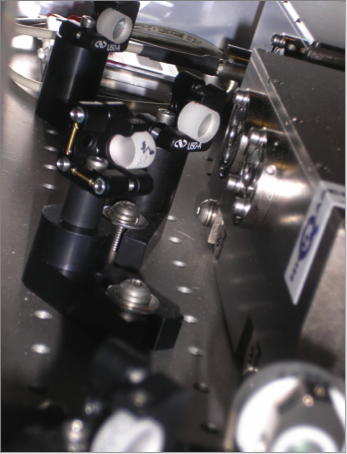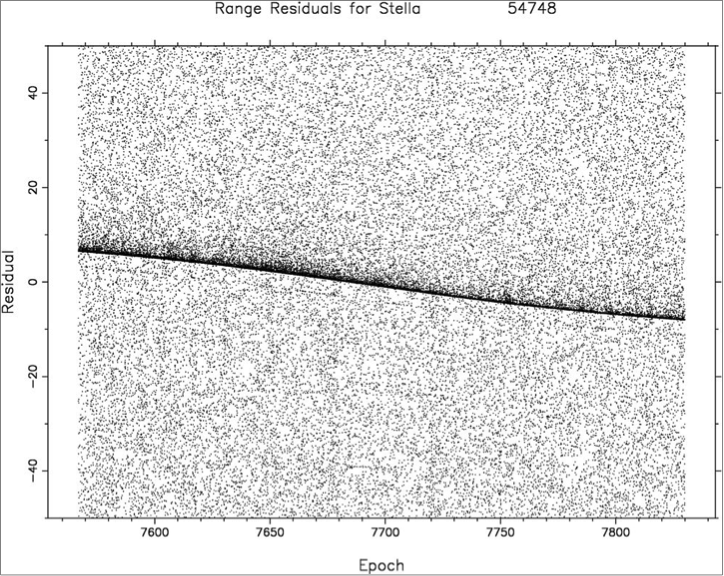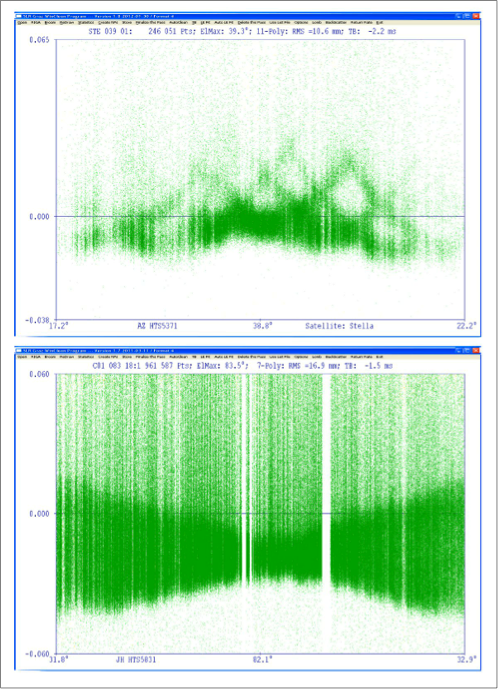Quick Links
Ground Segment
Every ILRS station has these key components for SLR tracking:
- a high energy pulsed laser
- an accurate timer
- a precise photon detector and
- a well mounted and agile telescope
Other components, capabilities, and features are:
- ultra stable clocks
- safety systems
- daytime observing and narrowband filters
- automation
- mobile SLR systems
These elements come in different forms at different stations and many stations have upgraded over recent years to the latest technology, which has improved station stability and data yield. Some of the new technologies are detailed on the linked pages above.
Lasers

A new generation of SLR lasers operate at high repetition rates, typically at 2kHz. The solid-state Nd:Van lasers (such as those installed at the Graz, Herstmonceux and Changchun stations) fire very short pulses, approximately 10ps wide with energies of ~0.4mJ, at 2kHz rates. This is a significant change to the more traditional laser systems which fire at around 10Hz with larger pulse energies and widths, e.g. 20-100mJ and 50-100ps. This change leads to greater single-shot precision, due to the narrower pulses used, and greater normal point precision due to the increased number of observations made. It however decreases the signal to noise ratio and some data processing is required to extract the satellite signals from the background noise. The tracking software used at the Herstmonceux station estimates normal point precision in real time, allowing for efficient satellite switching once a kHz normal point has reached a precision of 1mm.

The range window above shows a kHz pass of the Stella satellite from the Herstmonceux station, a lot of noise is present in the window but the satellite returns are clearly visible.

The short laser pulse width allows the Graz station to clearly distinguish individual retro-reflectors onboard satellites, as seen here for a Stella pas (top) and Compass-M1 pass (bottom).
High repetition rate SLR results in multiple laser shots being in-flight at any one time, requiring the use of an event timer as a more traditional interval timer could not handle these overlapping range measurements. Some kHz systems use a field-programmable gate array (FPGA) board, designed and developed in Graz, to control in hardware the fast updating of the range gate window. Another issue that arises for kHz systems is laser fire overlap, where the detector is armed to observe a returning pulse too shortly after another laser shot is fired and the backscatter is instead detected. This is avoided by adjusting as appropriate the laser fire rate to between 1950 and 2000Hz in real time.
The short laser pulses allow individual retro-reflectors to be distinguished. From modelling the orientation of each retro-reflector a satellite spin rate and spin axis orientation can be determined. Results from such analysis were presented by D. Kucharski at the 17th ILRS Workshop, see here.
Atmospheric studies using two-colour SLR are continuing using high repetition rate lasers at the Conception station, as presented at the 17th ILRS Workshop here, and are under development at the Wettzell station, also presented here.
The newer kHz Lasers are capable of up to 10 kHz and such repetition rates are being experimented with and will be used in SLR in near future, see here for the 17th Workshop presentation by G. Kirchner.
Example laser technology
Many stations, including Graz, Herstmonceux and Wettzell operate a laser designed and manufactured by the High-Q company (see here for report to the 16th ILRS Workshop). Zimmerwald operates a 100Hz laser manufactured by Thales, France. The Shanghai station uses a 1kHz laser provided by Photonics Industries, USA.
Timers
The time-of-flight of the laser light returning from the satellite must be measured very accurately (to about 10 picoseconds) to achieve the best results for SLR. In addition, a suitable timer needs to remain very stable in the short and long term. Many stations use single shot, interval timers but with the progress of kHz SLR systems, event timers are now largely favoured due to the need to handle multiple laser shots in flight.
An emerging technology for use as a SLR timer was reported to the 16th ILRS Workshop, which can be viewed here, which promises sub-picosecond event timing.
Read more about timers used at SLR stations.
Detectors
To detect a weak return signal of a few or single photons from satellites during SLR, stations use either a micro-channel plate (MCP) or an avalanche diode, typically a single photon avalanche diode (SPAD). Each detector type has its advantages.
SPAD Detectors
With detection fall times of less than 200ps, quantum efficiencies of >20%, detection jitter of 20-100ps and the ability to detect single photon events, the SPAD detectors are effective and widely used. The detectors however do exhibit and error dependent on incident signal intensity, termed 'time-walk', which can be controlled if the station consistently keeps to low single photon levels or alternatively a compensated C-SPAD channel corrects for this effect. SPADs can be armed 50-100ns before the expected signal, allowing for very close gating and consequent noise reduction. However, arming closer than 50ns risks introducing range errors of up to a cm. A disadvantage of the SPAD detector is that it is a single detection device, in that once it is armed it triggers on the first photon to arrive. The latest SPAD (as reported here to the 17th ILRS Workshop) is designed for kHz operations and has significantly reduced 'dark' noise, at about 200-300 kHz.
MCP-PMT Detectors
MCP detectors provide a continuous detection voltage that is fed into a discriminator for signal identification. The returning laser light first hits a photomultiplier tube which emits an electron which cascades through a micro channel plate channel releasing many electrons and an intensified signal. MCP-PMT detectors have undergone significant improvements in quantum efficiency levels in recent years, reaching 40% for some Hamamatsu detectors. Jitter levels vary at around 100ps with far less dark noise of around 30-300Hz.
Ultra Stable Clocks
To take part in time transfer experiments, either by GNSS receiver comparisons or by the Jason-2 T2L2 mission and other upcoming satellite missions, many stations have upgraded to on-site stable frequency sources. Active or passive Hydrogen Masers or Caesium Fountain frequency sources supply frequencies stable at about 1x10-15s per second.
Safety Systems
Any station near to a populated area is likely to be under flight paths and many stations regularly have aircraft crossing the sky during SLR. No currently operating SLR laser is deemed to be 'eye-safe' at any point in the Earth's atmosphere and so safety precautions are essential to avoid damaging the vision of pilots and passengers by a direct hit.
Traditionally stations use a wide field, tracking RADAR that follows the laser beam around the sky and shuts off the laser power automatically if an aircraft approaches the beam. However, the Zimmerwald station, for example, uses a direct feed from Switzerland's air-traffic control to monitor aircraft positions. A session at the 17th ILRS Workshop, see here, on in-sky safety contained details of new approaches to the issue.
As presented in this session and of particular interest are the transponders which are carried by most modern commercial aircraft. Receivers are available that can track these signals and relay the aircraft GPS co-ordinates. Once these beacons are fitted to all aircraft this technique could complement and eventually replace the standard RADAR systems.
Daytime Observing and Narrowband Filters
Operating during the day greatly increases the data yield from an individual station, however the signal to noise ratio is very low and spectral filtering is required. Optics with laser wavelength specific transmission bands of less that 1nm are introduced with a much wider 'blocking filter' in front of the detector. Some filters are oven controlled and tuned to the desired wavelength, usually 532nm. The standard bandwidth is about 0.3 nm.
Automation
All SLR stations are computer controlled but some need much less human interaction than others. The Zimmerwald automated station can set its own schedule, calibrate, search for satellites via telescope offsets and shutdown when the clouds (or rain) arrive. A session on station automation was held at the 17th ILRS Workshop and can be seen here.
Mobile SLR Systems

Mobile SLR stations can occupy and monitor a particular site for a fixed period before uprooting and moving to another location. This is particularly useful to fill in gaps in the ILRS station network, which is not evenly distributed globally. The French FTLRS mobile system is a small 13cm diameter telescope, mounted on top of a 10Hz, 20mJ laser, which is fixed to a tripod.See here for the FTLRS 16th ILRS Workshop report. Other mobile stations have been developed, including in Korea, see here, and in China, see here.




